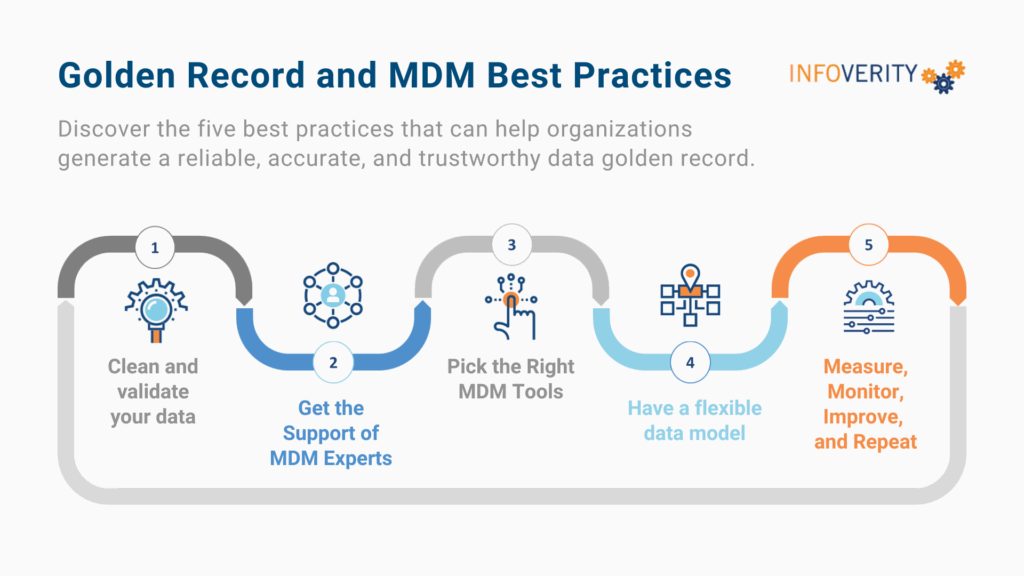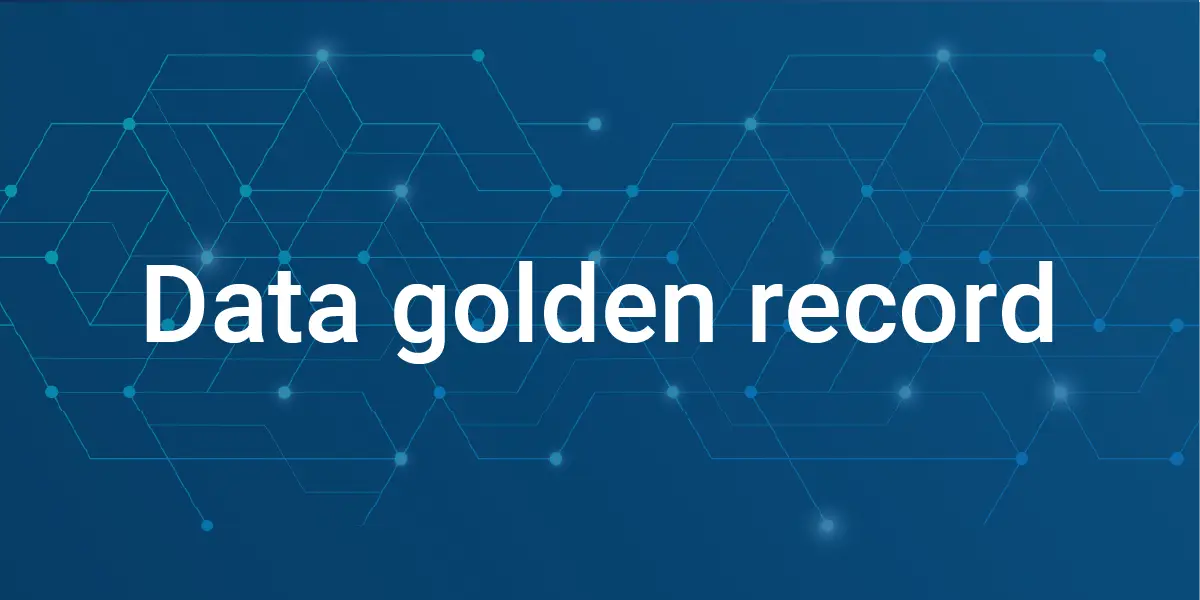In 1977, NASA sent two golden records into space aboard Voyager I & II, packed with information about Earth and its inhabitants. Fast forward to the 2020s, and a different type of golden record is now essential for modern data management.
Why are they essential? For your business to thrive, your data must be complete, accurate, and consolidated. Trustworthy input data is crucial, especially for deep learning—otherwise, your AI might suggest making pizza with glue! Golden records ensure your data is reliable and ready to drive innovation.
Research
81% of senior decision-makers surveyed by Dun & Bradstreet believe that the primary role of data is to help the business grow. Yet, to be effective for decision-making, regulatory compliance, business intelligence (BI), artificial intelligence (AI), sales, and marketing, it needs to be right.
In this article, we will discuss the essence of a data golden record and its pivotal role in data management. We will explore its challenges and discover best practices and tools.
Data Golden Record: Table of Contents
What is a Data Golden Record in Master Data Management (MDM)?
A data golden record is a single data point that includes all the most accurate information about a resource, supplier, or customer in a standard format. For instance, a client’s golden record will provide a comprehensive, up-to-date version of a customer’s information such as:
- Contact data
- Demographics
- KYC
- Related entities
- Tax details
- Alternate names and identifiers
- Segmentation and classification
in a single data entry available across the organization.
Why Is a Data Golden Record Important?
The data golden record is the basis for a successful data management program. It combines data from multiple sources, formats, and systems (e.g., ERPs and CRMs) into a standard format that can be developed into a canonical definition of a customer, supplier, product, location, asset, contact, and more.
It is a single data set holding consolidated, enriched, and verified data from your entire enterprise. A one-stop shop for analytics and stewardship empowers organizations to:
- Make better-informed decisions
- Improve data quality
- Streamline operational efficiency
- Minimize errors
- Eliminate duplicates and redundancies
All this is crucial in today’s data-driven business landscape where the quality and accuracy of data directly impact any organization’s success.
Furthermore, data golden record makes new system integrations child’s play. Whether you are adding new systems to enable new capabilities, or onboarding systems gained via acquisitions and mergers, once the information is mapped to MDM, the data automatically flows downstream.
Looking for Master Data Management (MDM) guidance?
Defining a golden record is your first step to centralized, trusted, and actionable data. Let Infoverity reshape your enterprise information with its best-in-class strategies and MDM solutions to unlock the true value of your data. 
4 Challenges of Identifying and Maintaining Data Golden Records
Turning chaotic information into clear, high-quality data by creating and managing a golden record is not as simple as it may look. According to a 2024 HFS report, over 40% of organizational data is of such bad quality that it is unusable.
Let’s have a look at the top four data challenges organizations face without golden records.
1. Poor Data Quality
Working with inaccurate, incomplete, or outdated data costs enterprises time and money. A recent Validity survey shows that 31% of administrators lost at least 20% of their annual revenue due to low data quality. Insufficient controls, lacking metrics, and poor understanding of data flows within the organization can quickly result in data quality issues. A well-thought-out golden record program can stop bad data at the source and make it easier to correct it.
2. Duplicated Records
A company might register a client as “J Doe Ltd” in its CRM system, while in the support team’s database, it appears as “John Doe Ltd”. Merging the two databases will result in two separate records. Multiple duplications will result in data being split over several records, forcing teams to work with incomplete information and incorrect sales data. Customers might receive duplicate or irrelevant promotional material, or inappropriate types or amounts of credit to be extended. Finally, your organization may have to deal with regulatory issues caused by incorrect data handling or insufficient KYC/KYS.
3. Data Silos
Nowadays, firms manage, on average, 400 data sources. The data is often stored in different formats, following different standards, with different access requirements. This makes it impossible for organizations to gain a holistic view of their data.
4. Maintenance and Governance
When data is authored and maintained in several different systems at once, it’s hard to ensure that it is consistent and reliable. However, it is crucial for a successful data management practice. Ensuring the data is consistent, trustworthy, and not misused is paramount considering expanding data protection and KYC/KYS regulations, and having a single location to perform stewardship and maintenance is the best way to make that happen.
5 Golden Record and Master Data Management Best Practices
Here, we have listed five best practices that can help organizations generate a reliable, accurate, and trustworthy data golden record.
1. Clean and validate your data
High-quality information is crucial for a perfect data golden record and an effective MDM.
Regularly cleaning, auditing, and validating your data will ensure that it is complete, up-to-date, accurate, and ready to analyze. Data quality checks and assessments will help you maintain the quality of your data and optimize it over time.
2. Get the Support of MDM Experts
You can implement data golden records the hard way by manually building an MDM equivalent in your DW/DL/ESB, but it will be extremely complex, and you may have a hard time winning the trust of your stakeholders. Infoverity expertise will help you go from data chaos to a clear, single source of truth.
3. Pick the Right MDM Tools
Choosing the correct MDM and data integration tools that meet your business’s needs is paramount. Discover how a non-profit healthcare organization successfully integrated multiple data sources, 11,000 siloed providers, legacy systems, and outdated ETL processes with an innovative data management solution provided by Infoverity.
4. Have a flexible data model
Build a flexible data model so that changes can be applied quickly and painlessly. For instance, a Fortune 500 subsidiary leveraged the power of a customized and flexible MDM to onboard 183,000 items in less than 24 hours, reduce the average time to market by 50%, and improve user satisfaction.
5. Measure, Monitor, Improve, and Repeat
Data golden records are dynamic in nature. They constantly change. This is why MDM is an ongoing process. Measure the performance of your data golden records, and keep an eye on critical metrics (e.g., data quality, security, and compliance). Once done, use the outcomes to improve your MDM strategy.

Designing a Customer 360 View and Customer Profile
A Customer 360 Dashboard provides a holistic view of a customer. To create it, organizations must follow a four step process:
1. Profile, Analyze and Cleanse Source Data
Once the data sources have been identified, from both internal and external systems, the data should be cleansed to ensure accuracy and completeness.
When done, the data can be ingested into a Master Data Management system.
2. Create a Golden Record and a Single Customer Profile
A master customer record (i.e., golden record) is generated to minimize inconsistencies. The record will then be used to build a comprehensive customer profile embedding all crucial information, such as:
- Revenue.
- Products purchased.
- Lifetime value.
- Customer service interactions.
- Channel interactions.
- Marketing behavior.
- Demographic data.
- Relationships.
3. Implement Data Governance and Security
In 2024, data privacy regulations like the European Union General Data Protection Regulation (EU GDPR) and the California Consumer Privacy Act (CCPA) are raising the stakes for all businesses. Compliance with these regulations requires rigorous data management practices.
Setting up data governance processes and policies will ensure data accuracy, security, and privacy. It will help organizations understand the best way to manage data in compliance with government and industry privacy regulations.
Both Consumers and Businesses value data security and privacy. According to Hubspot, 72% of surveyed consumers say they prefer to buy from businesses protecting their sensitive data.
4. Evaluate, Improve, and Update
Keep data up to date to capture changes to the customer view. Regular customer 360 view assessments will also facilitate the identification of areas for improvement and ensure data accuracy and completeness.
Transform Raw Data Into Gold
Defining a golden record and the steps to create it is your first step to centralized, trusted, and actionable data. However, achieving a trustworthy single source of truth has its challenges, and without an expert’s support can be a daunting task.
Let Infoverity reshape your enterprise information with its best-in-class strategies and MDM solutions so that you can unlock the true value of your data. Contact us today.
FAQ – Data golden source
What is a data golden source?
A data golden record is a single data point that includes all the most accurate information about a resource, supplier, or customer in a standard format. For instance, a client’s golden record will provide a comprehensive, up-to-date version of a customer’s information.
How to transform raw data into a golden database?
Defining a golden record and the steps to create it is your first step to centralized, trusted, and actionable data. However, achieving a trustworthy single source of truth has its challenges, and without an expert's support can be a daunting task. Let Infoverity reshape your enterprise information with its best-in-class strategies and MDM solutions.
Why is a data golden record important?
The data golden record is the basis for a successful data management program. It combines data from multiple sources, formats, and systems (e.g., ERPs and CRMs) into a standard format that can be developed into a canonical definition of a customer, supplier, product, location, asset, contact, and more.
What are the best practices for data golden records?
Creating a reliable data golden record starts with regular data cleaning and validation to ensure accuracy. Leverage MDM tools and expert guidance to simplify integration and build a flexible data model that adapts to change. Continuously monitor and refine your strategy to maintain data quality, compliance, and performance over time.



